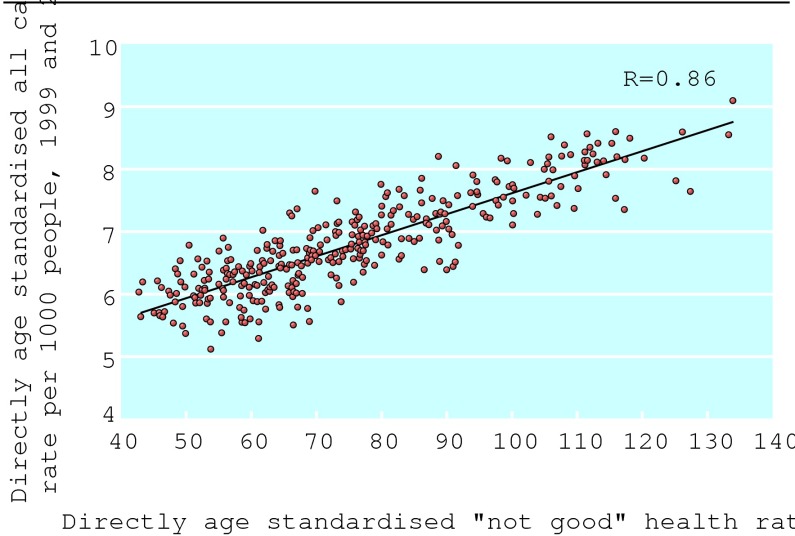Mortality rates are commonly used as summary measures of current health status when comparing different populations. Their use in this way is often criticised, however, because mortality rates, though readily available and objective, are such an extreme measure of ill health. Surveys of self reported health, as an alternative approach to quantifying the health of a population, tend to be regarded as flawed because of their subjectivity. The UK census in 2001 included two measures of self reported health. We compared their values for each local authority area with the mortality rates for each area to find out whether mortality and self reported health are correlated.
Methods and results
For each local authority area in England, we took the age standardised mortality rates for the major causes of death pooled for 1999 and 2001 from the Compendium of Clinical and Health Indicators.1
For the same areas, we calculated age standardised rates of self reported health status using data from the 2001 census,2 using the European population as the standard. For the census question on general health everyone was asked whether, over the past 12 months, their “health had on the whole been good, fairly good, or not good.” For the census question on limiting long term illness everyone was asked whether they had “any long term illness, health problem, or disability (including those due to old age)” which limited their daily activities or the work they could do. We plotted the rate for people in each local authority area who answered that their health had been “not good,” and for those who answered “yes” to the question about long term illness, against the mortality rates for each area for all causes, cancer, circulatory disease, and suicide. To take account of differences in the numbers of deaths between the local authority areas, we used weighted least squares regression to derive Pearson correlation coefficients.
Area rates for “not good” health and for death from all causes were strongly correlated (R = 0.86; figure), as were rates for limiting long term illness and death from all causes (R = 0.84). We also found strong correlations between area rates for “not good” health and for cancer (R = 0.79) and circulatory disease (R = 0.77). The correlation with suicide was evident but not as strong (R = 0.38). Rates of limiting long term illness and rates of death by specific causes showed similar patterns.
Figure 1.
Relationship between age standardised rates of self reported “not good” health and all causes mortality rates at local authority level, England
Comment
Mortality rates are highly correlated with the two census measures of self reported ill health at the level of local authority area. We cannot discount the possibility that, as measures of population health, mortality and self reported rates are both flawed in the same direction and to a similar extent. In other circumstances—for example, if comparing different cultures or for different time periods—the close relationship that we found may not hold.
What is already known on this topic
Mortality rates are commonly used as measures of population health, but this is often criticised as death is an extreme measure of ill health
Rates of self reported ill health also tend to be regarded as flawed because of their subjectivity
What this study adds
Comparing local authority areas in England, mortality rates are highly correlated with the two census measures of self reported ill health
We also noted the degree of scatter in the correlation: some local authorities with comparable mortality rates have quite different rates of self reported ill health and vice versa. If measures of either mortality or self reported ill health are used alone as weighting factors to determine allocation of resources to different areas, comparable levels of support could be received by areas with dissimilar need for services. In local authorities that have apparently large differences between their ranking on mortality and on self reported ill health, it may be worth exploring reasons for the difference.
For England as a whole, however, despite conceptual concerns about using either mortality or self reported ill health to measure the health status of different populations, there is a strong correlation between the two and each generally gives a similar profile.
Supplementary Material
This article was posted on bmj.com on 24 September 2004: http://bmj.com/cgi/doi/10.1136/bmj.38238.508021.F7
 Table A on bmj.com gives the correlation variables; the full results and details of excluded local authorities are on bmj.com
Table A on bmj.com gives the correlation variables; the full results and details of excluded local authorities are on bmj.com
Contributors: MJG proposed the study and wrote the first draft. RGEK analysed the data. All authors contributed to the design and interpretation of the study and to further drafts. RGEK is guarantor.
Funding: None.
Competing interests: None declared.
Ethical approval: Not needed.
References
- 1.Department of Health. Compendium of clinical and health indicators 2002. London: DoH, 2003.
- 2.Office for National Statistics. 2001 census of population. London: ONS, 2003. www.statistics.gov.uk/census2001 (accessed 10 Sep 2004).
Associated Data
This section collects any data citations, data availability statements, or supplementary materials included in this article.



